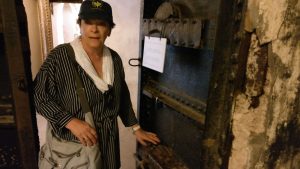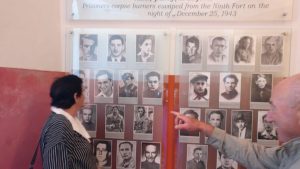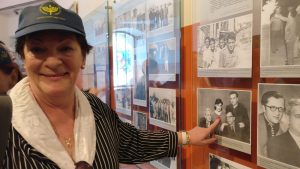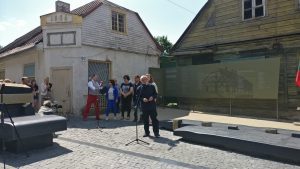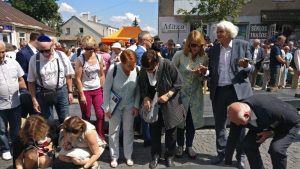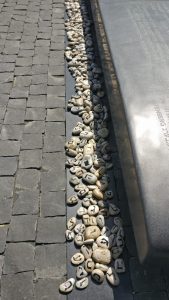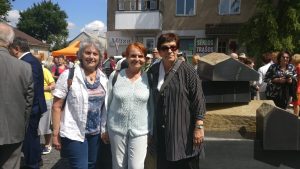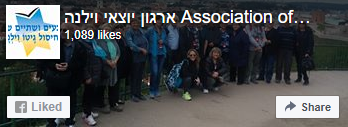75 years of Vilna and Kovno Ghettos liquidation
In July, 2019, Mickey Kantor, the chair person and Ya'arit Gezer – board member of the Association of Jews from Vilna and the Vicinity- participated in several memorial ceremonies in a number of places in Lithuania.
On Saturday, 13th of July a film by the researcher Rami Neudorfer, was screened at the "Best Baltic" Hotel in Kovno. Rami had found two tin boxes in the archives of the ghetto’s Jewish Police that had been buried by ghetto inmates. Among the documents, he found rare documentation about the ghetto’s orchestra which included Zionist songs in Hebrew.
The film relates the story of the ghetto orchestra which consisted of 40 musicians, and was established in 1942 by the musician Moishe Hofmekler. The orchestra continued its musical activities in the ghetto and, later on, also at Dachau.
On Sunday, 14th July, 2019 a memorial ceremony marking 75 years of the liquidation of Ghetto Kovno took place at the Ninth Fort in Kovno, which was organized by the Kovno Jewish community and the Ninth Fort Museum. Grisha Deutsch told the story of his father Mendel, who was among the cremators and he, like other inmates, had escaped from the killing valley. Pinchas Krakinovsky was the one who for days had secretly drilled holes in the thick iron gate thus enabling the entire group to flee to the forest and join the partisans. His daughter Ya'arit Glezer was present in the audience.
One of the prominent speakers was Amir Maimon, Israel’s Ambassador to Lithuania, who spoke about the important connection between the Holocaust, heroism and the existence of the State of Israel.
The ceremony, which took place next to the renovated monument on the site of the ghetto gate, was very moving. A wall of the house by the entrance to the ghetto was designed by local artist Vytenis Yakas. The house is planned to be the seat of the ghetto museum. A large number of people attended the ceremony which was organized by the Kovno municipality and the Jewish community. Speakers included the Deputy Mayor of Kovno, a representative of the Lithuanian parliament, Prof. Landsbergis - the son of the Righteous Among the Nations and the first President of Lithuania – local and national community leaders, ghetto survivors, public representatives, the Chairpersons of the Association of Lithuanian Jews in Israel and the Association of Jews from Vilna and Vicinity in Israel. A poem written in Hebrew by a ghetto survivor Rivka Discant – Krakinovsky was read out in Hebrew by her daughter Ya'arit. Iga Sofia Mekuteniene, the granddaughter of the Righteous Among the Nations Sofia Binkiene, was a honorable guest at the ceremony.
The Youth Orchestra of the Kiryat Ono Conservatory played songs and the anthems of the two countries.
A short, guided tour of the Ninth Fort museum followed. In addition to the explanations of the museum exhibits a group of visitors had gathered around Ya’arit Glezer who told the story of the escape of the group of 64 body- burners and among them her mother's youngest brother Aba Discant , as heard from her father, Pinchas Krakinovsky .
A concert given by the Youth Orchestra of the Kiryat Ono Conservatory, took place at the local Philharmonic Hall in Kovno. The large audience included visitors from Israel who had arrived with the orchestra, including the mayor of Kiryat Ono, friends and families, survivors and the following generations, members of Israeli organizations as well as representatives of the Vilna community. The tenor, Raphael Karpis, astounded the audience in the second half of the concert when he sang a medley of Jewish music.
On Monday, 15th July, Mickey and Ya’arit traveled to Vilna and attended a press conference at the Schulhof excavation site, where the mikveh and two of four pillars were exposed.
On Tuesday, 16th July, a meeting was held at Café Beigel, which is frequented by the Jewish community, with Sigutė Chlebinskaitė, a graphic editor and illustrator of art books. She had edited a translation into Lithuanian of the book ‘Yitzchak Rudashevski’s Diary’ and had taken part in the book-launching at Vilna House in Tel-Aviv.
Mickey and Ya’arit were personally invited by Dr. Mindaugas Kvietkauskas, Lithuania’s Minister of Culture, to a cordial meeting at the Ministry of Culture. The minister presented a work plan which included dozens of events relating to the Litvak legacy and the marking of the 300th anniversary of the birth of the Vilna Gaon, planned to take place over the following two years, beginning in 2020. The minister gave Ya’arit a copy (in Lithuanian) of the detailed program to be translated into Hebrew. Mindaugas translated Yitzchak Rudashevski’s Diary from Yiddish into Lithuanian and was present at the book-launching, held in May 2018, at Vilna House in Tel Aviv.
A lecture called The Archeology of the Holocaust: Vilna, Rhodes and Escape Tunnels, was held in the Jascha Heifetz Hall at the Community House, with the participation of Prof. Richard Freund, as well as Maurice Greenberg, a professor of Jewish history and director of Judaic Studies at the University of Hartford: on the application of the geophysical technique used in Vilna and Rhodes to simulate and evaluate the underground structures, and penetrate the ground without damaging it. Paul Jule/Joel talked about the students who took part in the excavation, Dr. Philip Ryder, who analyzed the maps which had become discolored over the years, talked about the special photographs which located the recommended points for the dig, and also revealed the exact location of the mikveh.
Prof. Freund, who collated the findings in the book, talked about his great-great-grandfather being a Litvak, and that he understood that his generation is in a race against time especially when it comes to eye witnesses. He decided to make the story of the Lithuanian Jewish community more accessible to the coming generations by recruiting youngsters from various places so that they could learn about the Holocaust as a matter of interest. This is so that people should understand that it is not possible to ignore the vestiges of the Holocaust that had, indeed, existed. Beit Vilna was presented with a copy of the book signed by Prof. Freund.
A fascinating debate took place at Vilna’s National Library about contemporary Israeli literature in Lithuania. The books which were displayed in the lobby included those by: A.B. Yehoshua, David Grossman, Dorit Rabinyan, Dror Mishani, Amos Oz and Zeruya Shalev. The book under discussion was ‘The Gospel according to Judah’ by Amos Oz.
Mindaugas Kvietkauskas, Lithuania’s Minister of Culture stressed the fact that the eight books already translated into Lithuanian, express the start of a dialogue between the two peoples. His favorite is Amos Oz’s book ‘The Gospel according to Judah’. Grossman's and Oz’s books were nominated for the Booker Prize, which is a literary prize awarded each year for the best novel written in English and, in his opinion, Oz is the winner. He is proud of the eight books translated into Lithuanian and is looking forward to eight Lithuanian books being translated into Hebrew.
Amir Maimon, Israeli Ambassador to Lithuania, who set the translations in motion, said that the rationale for the choice of books was whether he liked them or not. As far as he was concerned, having the books translated into Lithuanian was of benefit to both sides – to bring Israeli culture to Lithuania. Oz’s book is contemporary literature about our challenges, struggles and achievements as Israelis. It is a positive way of contesting our past and building a bridge between our past, present and future. He highlighted the fact that the Lithuanian Minister of Culture was party to the Lithuanian cultural activities in Israel, and added that the book written by Yossi Levi the incoming ambassador, was about to be translated into Lithuanian. Israeli culture is appreciated in Lithuania.
The following question was raised during the debate: How does ‘The Gospel according to Judah’ differ from Oz’s other books?
Donatas (one of the guests) said that the book was Oz’s interpretation of Judas Iscariot. He often sent friends who wanted to get to know Amos Oz equipped with translations of his books. He, himself, would bring Oz documents that had belonged to his father when he was a graduate at the University of Vilna. In fact, it had been a surprise to have found them. Man has two paths in life – his own existence and the country in which he lives and the connection to the world of his origins and roots. Jews are not just one race. They are a people of constant debate, argument and compromise.
In his opinion, Oz doesn’t only reflect Jewish identity but we can learn from it how we, the Lithuanians, can build our own identity.
Christina, who translated the book, drew attention to the fact that translating the book had been a real pleasure. Although the book is beautifully written it made her think about whom we call a traitor. With the euphoria of self-righteousness, it is easy to call someone a traitor. She wasn’t unfamiliar with the book so it was an agreeable undertaking for her. In order to understand the book, she reviewed religious texts to comprehend the symbols. This was both hard work and a great pleasure at one and the same time.
The question is: As a philosopher, how does she view the book from a philosophical aspect?
She sought to say that betrayal doesn’t always go hand in hand with guilt and that the circumstances should be reviewed in the light of cold logic. Judas was the first Christian who didn’t capitulate. He understood divinity differently and, until the day he died, believed that a miracle would happen. When he became disenchanted, he hanged himself.
Maimon told the audience that the fact of betrayal was important to Oz since, during the Mandate, he had become friendly with the British, for which his friends called him a ‘traitor’. Oz added that he was more likely to have become a doctor than a writer since he had been looking for a cure for fanaticism- a sense of humor that didn’t change a person’s nature. Oz is a writer who actually destroys historical myths in order to free man from his prejudices. As far as he is concerned, the translations are another brick in building a bridge between the peoples.
Thursday, 18th July, during an event at the National Museum of Art, Amir Maimon presented the museum director with a parting gift for the museum: an oil painting depicting a street in Petach Tikva by the Israeli artist Zvi Shorr. The painting had originally been presented to Maimon’s father, the late General David Maimon, upon his retirement, and is now on display at the National Museum of Art in Vilna.
The tenor, Raphael Karpis, entertained the participants with Jewish songs in Yiddish.
Friday, 19th July, an inauguration ceremony for a monument commemorating the Jewish community of Jurbarkas was held.
The ceremony was attended by many people from all over the world and was held at Kovno Street in the town center, where the remarkable monument created by the sculptor David Zundelovitz, was erected. This had been a unique project executed by the Zundelovitz family: David, his daughter Anna (an architect) and his son Greg (creative art director). Nika Zundelovitz, David’s granddaughter, sang the anthems of both countries.
The site is now called Synagogue Square (Schulhof) and is located very close to the old Zundelovitz family home. The sculpture is made from a wide basalt stone that symbolizes the Neris River (flowing near the town), upon which are engraved the names of all members of the Jewish community as well as the Righteous Among the Nations from Jurbarkas who had saved Jews. In the center is a sculpture of a ruined synagogue in black basalt. The monument is a daily reminder to the passers-by in the town center, about the cultural community which had lived here for centuries; it is a reminder that does not antagonize you but rather touches you deep inside.
Speakers at the ceremony included: David Zundelovitz, the town mayor Skirmantas Mockevicius , Amir Maimon, Philip Shapira, Faina Kukliansky.
A wonderful concert given by the Klaipėda Choir was held after the ceremony in the ancient town church where an exhibition of paintings by the artist Mina Levitan was also displayed. Mina’s family had managed to escape to Russia and survive. Later on, a meeting and dialogue with the monument creators took place at the municipal library.

